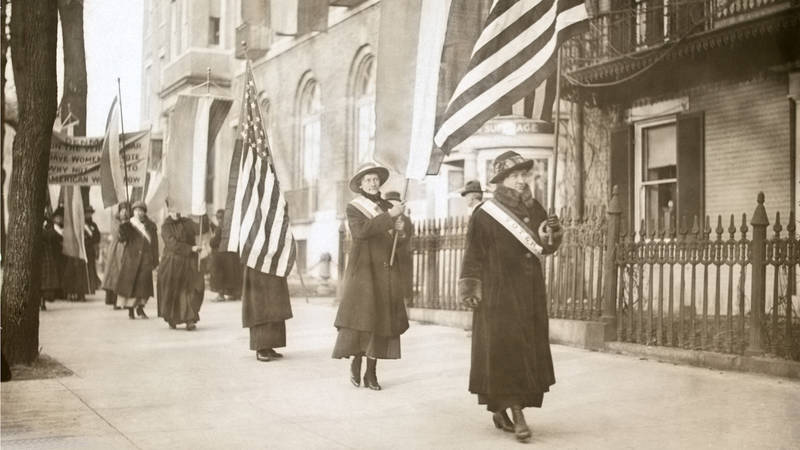Spring 2018
The Indian Chief and the President
In 1852, a 93-year-old Ojibwe chief traveled to Washington to stop the president from forcing his people off their ancestral lands.
The morning was fraught with anticipation. Chief Buffalo waited in his Washington, D.C., hotel, while his trusted adviser and translator, Benjamin Armstrong, walked along several downtown blocks with a heavy mind. Armstrong’s plan was to secure an interview with the commissioner of Indian affairs.
A couple of years earlier, in 1850, the U.S. president had issued an order to relocate the Ojibwe from the Lake Superior region. So Chief Buffalo, his deputy, Oshoga, four other Ojibwe men and Armstrong, a native Alabaman who had learned their language and married into Buffalo’s family, had traveled to the nation’s capital to make their case. Along the way, federal agents had attempted to stop them, and Armstrong was nervous when he showed up at the Interior Department.
It wasn’t long before his fears materialized. “I want you to take your Indians away on the next train west, as they have come here without permission,” the commissioner said, according to the account Armstrong published decades later, “and I do not want to see or hear of your Indians again.”
“I walked out more discouraged than ever and could not imagine what next I could do,” Armstrong wrote. The Ojibwe had never gone to war with the United States, but it was likely that they would if Buffalo’s diplomatic effort failed.
When the Ojibwe — also known by the anglicized name “Chippewa” — signed treaties with the U.S. in 1837 and 1842, they believed they had agreed only to let white settlers mine copper and cut timber for their houses. They thought they would be able to stay on their lands and continue their way of life as long as they were peaceful neighbors. So it came as a shock to them when President Zachary Taylor issued an order revoking their hunting and gathering rights and requiring them to move to “unceded” lands. “That was truly their home,” said Damon Panek, who is Ojibwe and works as a ranger at Apostle Islands National Lakeshore in Wisconsin, which was once part of the Ojibwe’s territory. “That’s where their ancestors had been and where they expected their future to be.”
The event later known as the Sandy Lake Tragedy reinforced the Ojibwe’s will to stake their ground. Under the terms of the treaties, the U.S. had agreed to make small annual payments to the Ojibwe, but late in 1850, the government moved the payment location from Madeline Island, one of the Apostle Islands and a spiritual and commercial center for the Ojibwe, to Sandy Lake in Minnesota. Thousands of Ojibwe made the trip, but when they arrived, the cash and goods were not there. They waited for weeks but only received a small portion of their due. By the time the Ojibwe returned home, some 400 people had died from the cold, starvation or dysentery. Many survivors called for revenge, but Buffalo, by then around 93, convinced his people to hold off until he made one last attempt to secure a peaceful solution.
On April 5, 1852, Buffalo and his six companions loaded their 24-foot birch canoe with provisions of sugar, crackers and coffee. They also packed a ceremonial pipe made specifically for the occasion. “The reason they took that pipe was for spiritual guidance,” said Marvin DeFoe, a tribal historic preservation officer with the Red Cliff Band of Lake Superior Chippewa. “Our environment went on that trip through that pipe.”
Along the south shore of Lake Superior, the group stopped to collect signatures for a petition they planned to present to Millard Fillmore, who had become president after Taylor’s sudden death. The support was overwhelming, and several local notables, who claimed to know the president personally, signed the petition.
After taking two steamboats and one train, Buffalo and his entourage arrived in New York with a single 10-cent silver coin left. To pay their hotel bill and continue their trip, they had to turn to New Yorkers eager to see Native Americans in the flesh. “They kind of exhibited themselves,” said Travis Armstrong, a descendant of Buffalo’s translator and a member of the Leech Lake Band of Ojibwe.
Finally, two and a half months after setting out, the group arrived in Washington. The next day, Armstrong made his unsuccessful appeal at the Interior Department. Dejected, he returned to his hotel to find a surprising scene in the lobby. A crowd had formed around Buffalo, and by chance, a New York senator and several members of the president’s Cabinet were among the curious onlookers. Upon hearing of the group’s predicament, the politicians promised to secure an interview with the president for them. Within 24 hours, Buffalo was offering his lit pipe to President Fillmore. The president took a few draws before listening to Buffalo and Oshoga explain the reason for their visit. Fillmore did, in fact, recognize some of the names on the petition that Armstrong handed to him.
Two days later, Fillmore summoned the Ojibwe delegation back to the White House and told them he would rescind the removal order and move the payment of annuities back to Madeline Island.
“When they went back, they traveled through a number of Ojibwe villages, and there was so much joy,” said Patty Loew, the author of several books about Wisconsin’s native people and a member of the Bad River Band of Lake Superior Ojibwe.

National Parks
You can read this and other stories about history, nature, culture, art, conservation, travel, science and more in National Parks magazine. Your tax-deductible membership donation of $25 or more entitles…
See more ›The Ojibwe subsequently ceded much of their land in yet another treaty in 1854. But thanks in part to Buffalo, one of the main negotiators, the agreement established several reservations in their homeland, including Bad River and Red Cliff on the shores of Lake Superior, and they retained their rights to fish and hunt throughout the region. DeFoe said his ancestors made the best deal they could. “We were able to survive,” he said. “That’s a victory.”
Buffalo died the following year at the age of 96 and is buried on Madeline Island. Armstrong built a cabin on Oak Island, now part of Apostle Islands National Lakeshore, and he continued to act as a translator for the Ojibwe, including on an 1862 trip to meet Abraham Lincoln.
After the meeting with Fillmore, Buffalo entrusted Armstrong with the pipe, but as time passed, the Ojibwe lost track of the artifact. Then a few years ago, a descendant of Armstrong contacted people at Red Cliff and handed over the pipe, DeFoe said. Nowadays, it comes out only for special ceremonies.
“We hold that pipe very sacred,” DeFoe said. “It’s kept in a safe place.”
About the author
-
 Nicolas Brulliard Senior Editor
Nicolas Brulliard Senior EditorNicolas is a journalist and former geologist who joined NPCA in November 2015. He writes and edits online content for NPCA and serves as senior editor of National Parks magazine.



